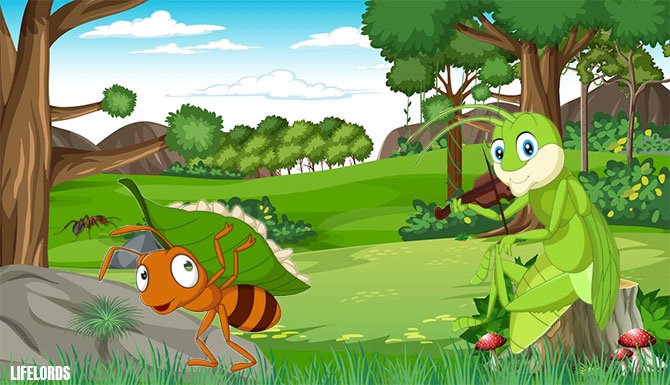One of Aesop’s most enduring fables, The Ant and the Grasshopper, presents a deceptively simple story that has sparked philosophical debates for centuries. The traditional version depicts a diligent ant working tirelessly throughout summer to store food, while a carefree grasshopper spends his days singing and dancing, only to face starvation when winter arrives. But beneath this straightforward narrative lies a complex tapestry of cultural interpretations, psychological insights, and historical adaptations that reveal why this story remains profoundly relevant from ancient Greece to modern boardrooms. The original Greek version from 6th century BCE was far more severe than contemporary retellings – the grasshopper didn’t just suffer hunger but actually died from his laziness, reflecting the harsh realities of agrarian societies where winter preparation meant literal survival. What few realize is that this fable exists in nearly every culture with seasonal changes: Chinese versions feature a cricket instead of a grasshopper, Scandinavian adaptations use a bee and a butterfly, while African oral traditions often replace the ant with a squirrel. These variations reveal a universal human truth – every society must balance present enjoyment against future security.
The characters themselves are masterclasses in symbolic representation. The ant embodies more than just hard work; it represents foresight, discipline, and the understanding that time is cyclical rather than linear. Modern psychologists might view the ant as demonstrating “delayed gratification” – the ability to resist immediate pleasures for long-term rewards, a trait famously linked to success in Walter Mischel’s marshmallow experiments. The grasshopper, often misunderstood as merely lazy, actually represents a philosophy of carpe diem – the artistic temperament that values beauty and joy above material concerns. This duality explains why the fable has been reinterpreted across eras: during the Renaissance, it was used to criticize extravagant nobility; Industrial Revolution versions framed the ant as the ideal factory worker; while Depression-era retellings emphasized the ant’s pantry as financial savings. The changing seasons serve as the story’s silent protagonist – summer representing abundance and opportunity, winter symbolizing life’s inevitable hardships. This seasonal metaphor extends beyond agriculture to modern concepts like economic cycles, career planning, and even climate change preparedness.
Historical context reveals surprising depth to this simple tale. Aesop, believed to have been a slave in ancient Greece, likely used the fable to critique Athenian aristocracy’s extravagance before the Persian Wars. Roman versions added a twist where the grasshopper begs the ant for help but is refused – a controversial ending that philosophers like Seneca debated as either just punishment or heartless rigidity. This moral ambiguity sparked one of the fable’s most fascinating adaptations: in 20th century France, Jean de La Fontaine softened the ending by having the ant share food, reflecting Christian values of charity. Modern children’s books often follow this gentler version, while business seminars use the original harsher conclusion to teach financial responsibility. The story’s flexibility across moral frameworks – from social Darwinism to socialist welfare – demonstrates its narrative power.

Scientific discoveries have added new layers to this ancient tale. Entomologists note that real ants don’t actually store food for winter but enter diapause (insect hibernation), while grasshoppers die seasonally leaving only eggs – facts that make the fable’s biological accuracy questionable but its symbolic truth enduring. Behavioral economists cite the story when explaining hyperbolic discounting – humans’ tendency to prioritize short-term rewards like the grasshopper. Interestingly, the fable’s lesson aligns with the latest research on “antifragility” – systems that grow stronger from stress, much like the ant thrives because it prepares for hardship. Silicon Valley entrepreneurs have even co-opted the metaphor, with “ant startups” focusing on slow growth versus “grasshopper startups” chasing rapid but unstable success.
The fable’s visual symbolism bears examination. Traditional illustrations depict the ant as angular and mechanical, the grasshopper as curvaceous and vibrant – visual shorthand for their opposing worldviews. In Japanese manga versions, the grasshopper often becomes a sympathetic artist figure, while Russian Soviet-era illustrations portrayed the ant as a collective farm worker. These artistic choices reveal cultural values: Western versions emphasize individual responsibility, while some Eastern interpretations consider community support. The tools used – the ant’s grain basket versus the grasshopper’s musical instruments – create a visual debate between practicality and artistry that resonates in education systems worldwide.
Modern applications abound. Financial advisors reference the fable when discussing emergency funds, psychologists use it to explain executive function in ADHD patients, and environmentalists draw parallels to sustainable resource management. The story’s most controversial modern interpretation appears in political discourse, where it’s invoked in debates about social welfare systems – is society the ant that must prepare, or should it help grasshoppers in need? This tension between accountability and compassion keeps the fable relevant in 21st century policy discussions. Educational researchers have found children as young as five grasp the story’s basic lesson, but only by adolescence do they understand its nuanced social contracts – a developmental progression that mirrors humanity’s own evolving relationship with this ancient narrative.
What makes The Ant and the Grasshopper truly timeless is its balance of simplicity and depth. On one level, it’s a straightforward warning about preparation. On another, it’s a meditation on time management, social contracts, and the eternal human struggle to balance present joy against future security. The story contains no villains – just different approaches to life’s inevitabilities. Contemporary rewrites have given the grasshopper redemption arcs where he learns responsibility, or the ant learns to appreciate music, showing our modern desire for balanced living. Yet the original’s uncompromising message still resonates: nature (and life) favors those who understand its rhythms. From ancient farmers to modern investors, from parents teaching children to CEOs planning quarterlies, the ant’s lesson remains unchanged – summer always ends, and winter always comes, but wisdom lies in knowing both will return, and preparing accordingly.
Go to main page


